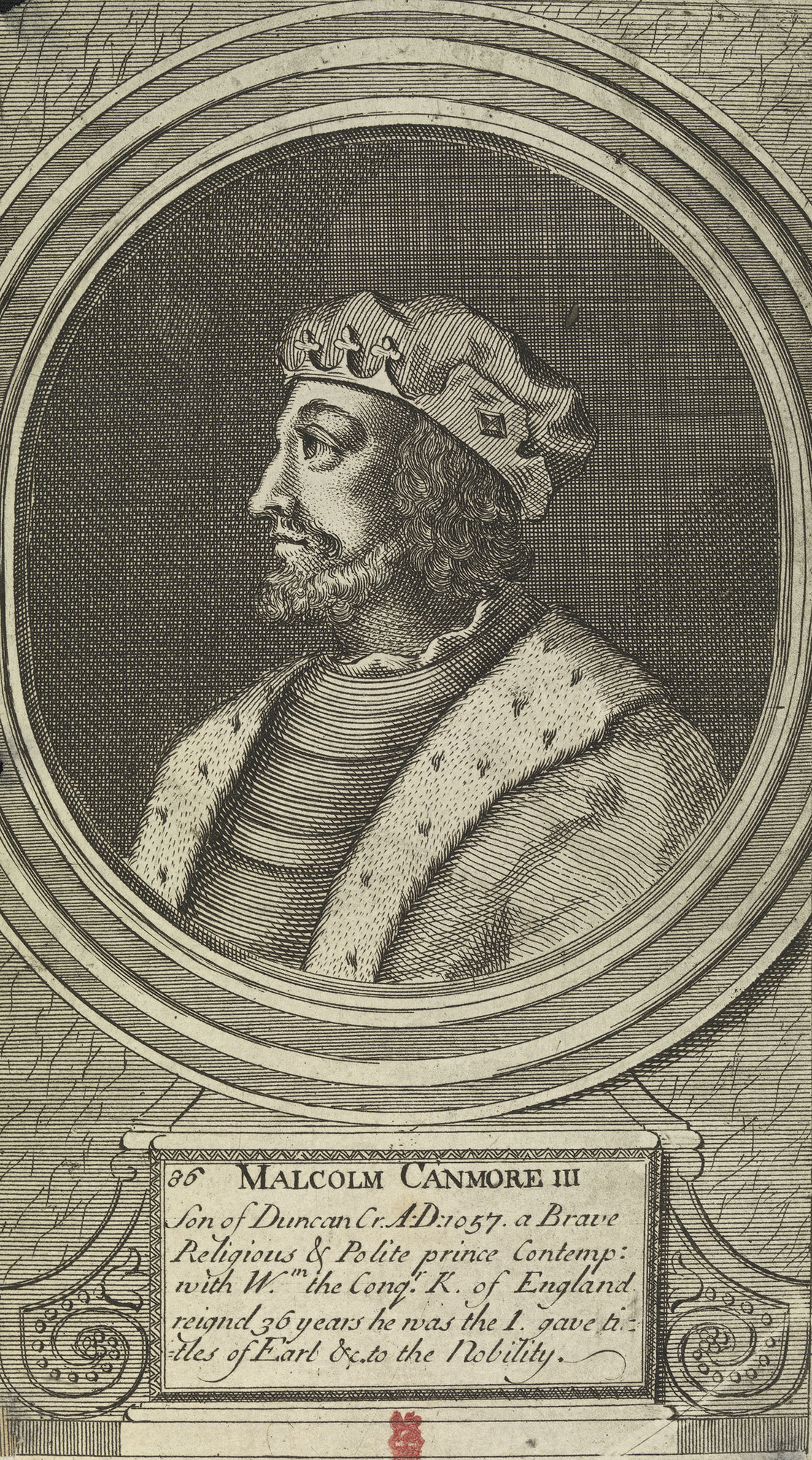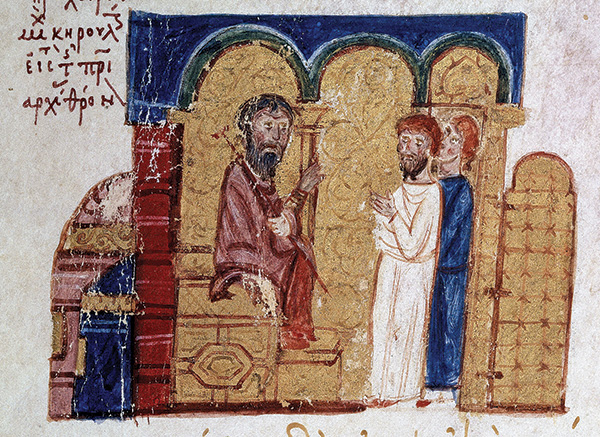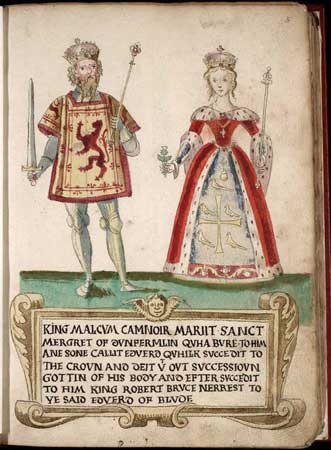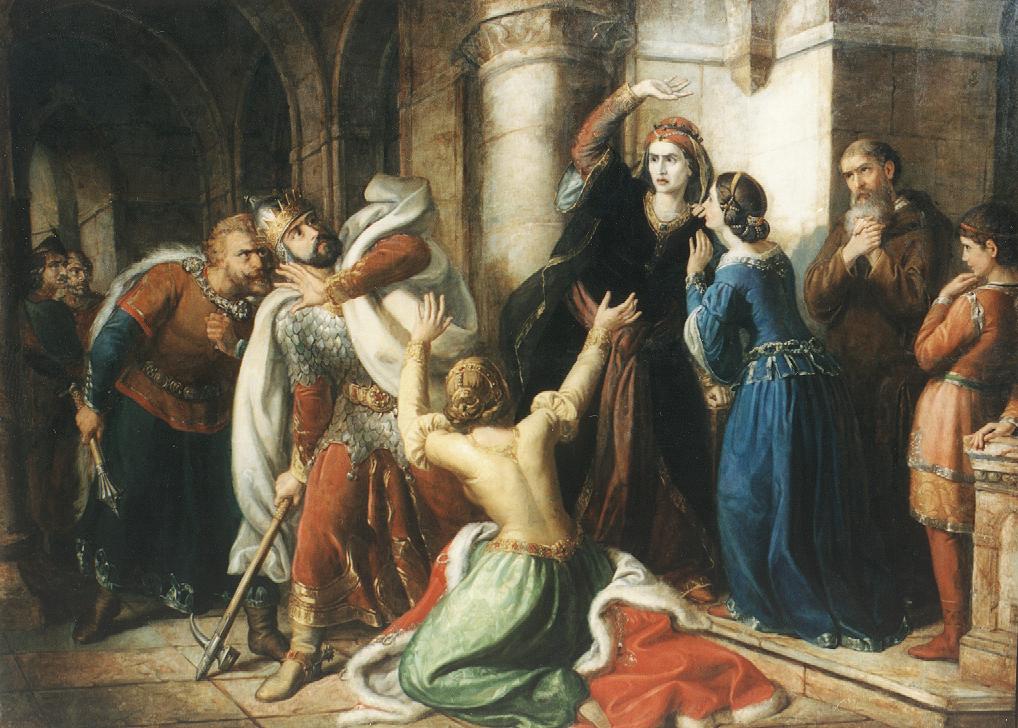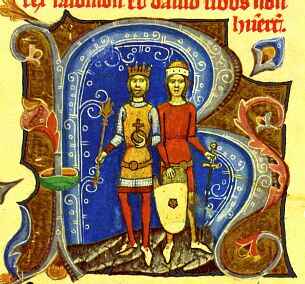|
1058
Year 1058 ( MLVIII) was a common year starting on Thursday of the Julian calendar. Events By place Europe * March 17 – King Lulach ("the Unfortunate") of Scotland is killed in battle against his cousin and rival Malcolm III ("Canmore") who becomes king of the Scots. * September 20 – Empress Agnes de Poitou and King Andrew I ("the White") of Hungary meet to negotiate about the border zone in Burgenland (modern Austria). * 4-year-old Judith of Swabia, youngest daughter of the late Henry III, Holy Roman Emperor, is engaged to Prince Solomon of Hungary at Regensburg. * Norman conquest of southern Italy: Norman forces under Richard Drengot besiege and capture Capua. He takes the princely title from Prince Landulf VIII. * Bolesław II the Generous, eldest son of Casimir I the Restorer, succeeds his father after his death in Poznań and becomes duke of Poland. Africa * The Almoravids conquer the Barghawata, a group of Berber tribes, who have establ ... [...More Info...] [...Related Items...] OR: [Wikipedia] [Google] [Baidu] |
Pope Stephen IX
Pope Stephen IX (, christened Frederick; – 29 March 1058) was the Bishop of Rome and ruler of the Papal States from 3 August 1057 to his death on 29 March 1058. He was a member of the Ardenne-Verdun family, who ruled the Duchy of Lorraine, and started his ecclesiastical career as a canon (priest), canon in Liège. He was invited to Rome by Pope Leo IX, who made him papal chancellor, chancellor in 1051 and one of three papal legate, legates to Constantinople in 1054. The failure of their negotiations with Patriarch Michael I Cerularius of Constantinople and Archbishop Leo of Ohrid led to the permanent East–West Schism. He continued as chancellor to the next pope, Pope Victor II, Victor II, and was elected abbot of the Benedictine monastery of Montecassino. Stephen was papal selection before 1059, elected to succeed Victor on 2 August 1057. As pope, Stephen retained the Montecassino abbacy, enforced the Gregorian Reform, and continued Leo IX's effort ... [...More Info...] [...Related Items...] OR: [Wikipedia] [Google] [Baidu] |
Lulach
Lulach mac Gille Coemgáin ( Modern Gaelic: ''Lughlagh mac Gille Chomghain'', known in English simply as Lulach, and nicknamed Tairbith, "the Unfortunate" and Fatuus, "the Simple-minded" or "the Foolish"; c. 1032 – 17 March 1058) was King of Alba (Scotland) between 15 August 1057 and 17 March 1058. Lulach was the son of Gruoch of Scotland, from her first marriage to Gille Coemgáin, Mormaer of Moray, and thus the stepson of Macbeth (Mac Bethad mac Findlaích). Through his mother, he was also the great-grandson of either Kenneth II or Kenneth III. Following the death of Macbeth at the Battle of Lumphanan on 15 August 1057, the king's followers placed Lulach on the throne. He has the distinction of being the first king of Scotland of whom there are coronation details available: he was crowned, probably on 8 September 1057 at Scone. Lulach appears to have been a weak king, as his nicknames suggest, and ruled only for a few months before being assassinated and usurped by M ... [...More Info...] [...Related Items...] OR: [Wikipedia] [Google] [Baidu] |
Malcolm III Of Scotland
Malcolm III (; ; –13 November 1093) was List of Scottish monarchs, King of Alba from 1058 to 1093. He was later nicknamed "Canmore" (, , understood as "great chief"). Malcolm's long reign of 35 years preceded the beginning of the Scoto-Norman age. Henry I of England and Eustace III, Count of Boulogne were his sons-in-law, making him the maternal grandfather of Empress Matilda, William Adelin and Matilda I, Countess of Boulogne. All three of them were prominent in English politics during the 12th century. Malcolm's kingdom did not extend over the full territory of modern Scotland: many of the islands and the land north of the River Oykel were Scandinavian, and south of the Firth of Forth there were numerous independent or semi-independent realms, including the kingdom of Strathclyde and rulers of Bamburgh, Bamburgh, and it is not certain what if any power the Scots exerted there on Malcolm's accession. Throughout his reign Malcolm III led at least five invasions into Kingdom o ... [...More Info...] [...Related Items...] OR: [Wikipedia] [Google] [Baidu] |
Casimir I The Restorer
Casimir I the Restorer (; 25 July 1016 – 19 March 1058), a member of the Piast dynasty, was the duke of Poland from 1040 until his death. Casimir was the son of Mieszko II Lambert and Richeza of Lotharingia. He is known as the Restorer because he managed to reunite parts of the Kingdom of Poland after a period of turmoil. He reincorporated Masovia and conquered Silesia and Pomerania. However, he failed to crown himself King of Poland, mainly because of internal and external threats to his rule. Biography Early years Relatively little is known of Casimir's early life. He must have spent his childhood at the royal court of Poland in Gniezno. In order to acquire a proper education, he was sent to one of the Polish monasteries in 1026. According to some older sources he initially wanted to have a career in the Church (it is probable that he held the post of oblate) and even asked for a dispensation to become a monk. This hypothesis, however, is not supported by modern historians. Re ... [...More Info...] [...Related Items...] OR: [Wikipedia] [Google] [Baidu] |
Barghawata
The Barghawatas (or Barghwata, Berghouata) were a Berbers, Berber tribal confederation and religious movement that ruled a region of the Atlantic Ocean, Atlantic coast in present-day Morocco between the 8th and 11th centuries. They belonged to the Masmuda confederacy. After allying with the Sufri Berber Revolt, rebellion against the Umayyad Caliphate, they established an independent state (AD744-1058) in the area of Tamasna, Tamesna on the Atlantic coast between Safi, Morocco, Safi and Salé under the leadership of Tarif al-Matghari. Etymology Some historians believe that the term ''Barghawata'' is a phonetic deformation of the term ''Barbati'', a nickname which Tarif carried. It is thought that he was born in the area of Barbate, near Cádiz in Spain. However, Jérôme Carcopino and other historians think the name is much older and the tribe is the same as that which the Ancient Rome, Romans called ''Baquates'', who up until the 7th century lived near Volubilis. History Few deta ... [...More Info...] [...Related Items...] OR: [Wikipedia] [Google] [Baidu] |
Norman Conquest Of Southern Italy
The Norman conquest of southern Italy lasted from 999 to 1194, involving many battles and independent conquerors. In 1130, the territories in southern Italy united as the Kingdom of Sicily, which included the island of Sicily, the southern third of the Italian Peninsula (including Benevento, which was briefly held twice), the archipelago of Malta, and parts of North Africa. Itinerant Norman forces arrived in southern Italy as mercenaries in the service of Lombard and Byzantine factions, communicating swiftly back home news about opportunities in the Mediterranean. These groups gathered in several places, establishing fiefdoms and states of their own, uniting and elevating their status to ''de facto'' independence within 50 years of their arrival. Unlike the Norman Conquest of England (1066), which took a few years after one decisive battle, the conquest of southern Italy was the product of decades and a number of battles, few decisive. Many territories were conquered indep ... [...More Info...] [...Related Items...] OR: [Wikipedia] [Google] [Baidu] |
Almoravid Dynasty
The Almoravid dynasty () was a Berber Muslim dynasty centered in the territory of present-day Morocco. It established an empire that stretched over the western Maghreb and Al-Andalus, starting in the 1050s and lasting until its fall to the Almohads in 1147. The Almoravids emerged from a coalition of the Lamtuna, Gudala, and Massufa, nomadic Berber tribes living in what is now Mauritania and the Western Sahara, traversing the territory between the Draa, the Niger, and the Senegal rivers. During their expansion into the Maghreb, they founded the city of Marrakesh as a capital, . Shortly after this, the empire was divided into two branches: a northern one centered in the Maghreb, led by Yusuf ibn Tashfin and his descendants, and a southern one based in the Sahara, led by Abu Bakr ibn Umar and his descendants. The Almoravids expanded their control to al-Andalus (the Muslim territories in Iberia) and were crucial in temporarily halting the advance of the Christian kingdoms in ... [...More Info...] [...Related Items...] OR: [Wikipedia] [Google] [Baidu] |
Landulf VIII Of Capua
Landulf VIIIHe is also numbered Landulf V or VI because the first two Landulfs of Capua, who were not princes, are sometimes ignored in the numbering, as well as another Landulf, who was only a co-ruler. was the last Lombard prince of Capua from 1057, when his brother Pandulf VI died, to the conquest of the city in 1058 by Count Richard of Aversa. Landulf was first associated with the rule along with his brother in 1047, when their father, the infamous Pandulf IV, was reinstated as prince for the second time. According to the ''Catalogus Principum Capuæ'', he reigned for twelve years, which would correspond to his rule jointly with his brother from their father's death in 1050 until his final expulsion from Capua. According to the ''Annali di Napoli'', the city of Capua itself was not fully captured by Richard until 21 May 1062. Landulf was probably forced to surrender the keys to the city to Richard and his son Jordan in 1058, but allowed to continue ruling until 1062. Landu ... [...More Info...] [...Related Items...] OR: [Wikipedia] [Google] [Baidu] |
Richard I Of Capua
Richard Drengot (''c.'' 1025 – died 1078) was the count of Aversa (1049–1078), prince of Capua (1058–1078, as Richard I) and duke of Gaeta (1064–1078). Early career in Italy Richard, who came from near Dieppe in the Pays de Caux in eastern Normandy, was the son of Asclettin I, count of Acerenza, younger brother of Asclettin II, count of Aversa, and nephew of Rainulf Drengot. Richard arrived in Southern Italy shortly after Rainulf's death in 1045, accompanied by forty Norman knights. When he first arrived in Aversa, according to Amatus of Montecassino Richard was well received by the people who followed him as if he were a count.''The History of the Normans by Amatus of Montecassino'', trans. Prescott N. Dunbar, ed. Graham A Loud (Woodbridge: Boydell Press, 2004), p. 84 He was described as strikingly handsome, a young man of open countenance who by design rode a horse so small his feet nearly touched the ground.The eleventh-century warhorse was usually smaller, usuall ... [...More Info...] [...Related Items...] OR: [Wikipedia] [Google] [Baidu] |
Solomon, King Of Hungary
Solomon, also Salomon (; 1053–1087) was King of Hungary from 1063. Being the elder son of Andrew I, he was crowned king in his father's lifetime in 1057 or 1058. However, he was forced to flee from Hungary after his uncle, Béla I, dethroned Andrew in 1060. Assisted by German troops, Solomon returned and was again crowned king in 1063. On this occasion he married Judith, sister of Henry IV, Holy Roman Emperor. In the following year he reached an agreement with his cousins, the three sons of Béla I. Géza, Ladislaus and Lampert acknowledged Solomon's rule, but in exchange received one-third of the kingdom as a separate duchy. In the following years, Solomon and his cousins jointly fought against the Czechs, the Cumans and other enemies of the kingdom. Their relationship deteriorated in the early 1070s and Géza rebelled against him. Solomon could only maintain his rule in a small zone along the western frontiers of Hungary after his defeat in the Battle of Mogyoród on 14 Ma ... [...More Info...] [...Related Items...] OR: [Wikipedia] [Google] [Baidu] |
Andrew I Of Hungary
Andrew I the White or the Catholic ( or ; 1015 – before 6 December 1060) was King of Hungary from 1046 to 1060. He descended from a younger branch of the Árpád dynasty. After he spent fifteen years in exile, an extensive revolt by the pagan Hungarians enabled him to take the throne from King Peter Orseolo. He strengthened the position of Catholic Church, Catholicism in the Kingdom of Hungary and successfully defended its independence against the Holy Roman Empire. His efforts to ensure the succession of his son, Solomon, King of Hungary, Solomon, resulted in the open revolt of his brother Béla I of Hungary, Béla. Béla dethroned Andrew by force in 1060. Andrew suffered severe injuries during the fighting and died before his brother was crowned king. Early life Childhood (c. 1015–1031) Medieval sources provide Vazul#Family, two contradictory reports of the parents of Andrew and his two brothers, Levente and Béla I of Hungary, Béla. The ''Chronicle of Zagreb'' and '' ... [...More Info...] [...Related Items...] OR: [Wikipedia] [Google] [Baidu] |
September 20
Events Pre-1600 *1058 – Agnes of Poitou and Andrew I of Hungary meet to negotiate about the border territory of Burgenland. *1066 – At the Battle of Fulford, Harald Hardrada defeats earls Morcar and Edwin. * 1187 – Saladin begins the Siege of Jerusalem. * 1260 – The Great Prussian Uprising among the old Prussians begins against the Teutonic Knights. *1378 – Cardinal Robert of Geneva is elected as Pope Clement VII, beginning the Papal schism. * 1498 – The Nankai tsunami washes away the building housing the Great Buddha at Kōtoku-in; it has been located outside ever since. * 1519 – Ferdinand Magellan sets sail from Sanlúcar de Barrameda with about 270 men on his expedition which ultimately culminates in the first circumnavigation of the globe. *1586 – A number of conspirators in the Babington Plot are hanged, drawn and quartered. 1601–1900 * 1602 – The Spanish-held Dutch town of Grave capitulates to a besieging Du ... [...More Info...] [...Related Items...] OR: [Wikipedia] [Google] [Baidu] |
